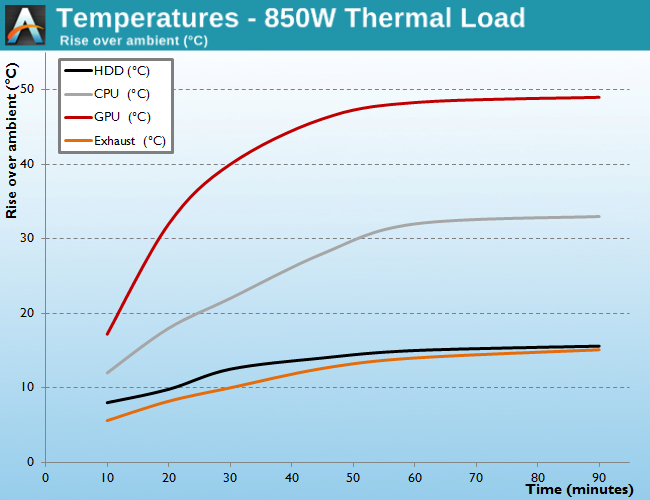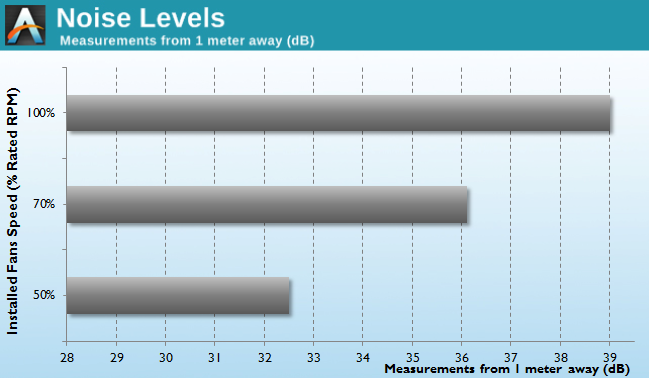Corsair Graphite 760T Case Review
by E. Fylladitakis on March 27, 2014 1:10 PM ESTTest Setup
Professional testing requires the emulation of real-world situations but with repeatable results; thus, a perfectly controllable test setup and environment are required, especially for comparable results. Testing the thermal performance of any case with a typical real-world setup technically limits the comparability of the results to this setup alone, as an active system interacts with its environment and the change of a single component alters (albeit in small ways) myriads of variables. In order to eliminate such factors, we developed synthetic loads that emulate the thermal output of real systems that are passive, steady and quantifiable.
Our thermal testing now displays the thermal capabilities of the case alone, as if it must deal with the entire thermal load by itself, regardless of the system that might be installed inside it. Laboratory data loggers are used to monitor the PT100 sensors and control the safety relays, which are fully accessible via our custom software. Three such loads have been developed, and today we'll be using the ATX load.
The ATX version simulates a 200W CPU, 50W VRM, 30W RAM and 4 × 120W GFX card thermal load; additionally, three 3.5" HDD dummy loads are also present that each convert 30W of electrical power to thermal, bringing the total thermal load of the ATX test setup up to 850W. As such, the thermal load is immense and only the best of cases will be able to handle it for more than a few minutes. We also test with a thermal load of 400W, with all of the aforementioned components except the HDD drives at about 42% power, which is more suitable for the majority of cases.
Thermal testing is performed with all of the case's stock fan operating at maximum speed. Noise testing is performed with a background noise level of 30.4dB(A).The top panel cover remained installed.
Results and Discussion
The thermal performance of the Corsair Graphite 760T is rather good but we cannot really claim that it is great considering the size and nature of the case. The stock cooling fans are not very powerful and ventilation depends on them while the top panel cover remains attached. It performed well enough to compete with mid-tower cases designed for maximum thermal performance, such as the Obsidian 450D, but the Graphite 760T is significantly larger and pricier.
The reduction of the load down to 400 Watts displays that the Graphite 760T has mediocre thermal inertia for a case this size. It appears that the thermal performance of the Graphite 760T heavily depends on the airflow of the cooling fans, at least while the top panel cover remains attached.
Probably due to the nature of the Graphite 760T, virtually no measures have been taken in order to reduce the noise coming from the case. Only the 3.5" devices are decoupled from the chassis; any vibrations from the PSU will be transferred directly to the chassis, as the unit sits on the metallic bottom of the case. The fascia not only is heavily perforated but it also has two 140mm fans directly exposed to the front of the case. The plastic cover of the top panel can block some of the noise but removing it exposes the entire top side of the case as well. As such, the Graphite 760T is definitely not a case specifically designed for silent computing. Nevertheless, the stock fans are not loud at all; they will be clearly audible only at their maximum speed and they reach virtually inaudible levels as soon as their voltage goes below 8V.













71 Comments
View All Comments
rcarlos243 - Thursday, March 27, 2014 - link
$189 for a plastic case, really....mmrezaie - Thursday, March 27, 2014 - link
apparently!chrome_slinky - Thursday, March 27, 2014 - link
I agree, it is a lot for that. Also, 3 5.25" open to the front? For that kind of money, I'd expect to see at least 4, and preferably 5 or 6. Simply because most don't use removable media doesn't mean that everyone is that way, and besides, there are some two and three bay displays which would severely limit this case in usefulness, were they to be a part of the build.peterfares - Thursday, March 27, 2014 - link
Front drive bays is a bit of an odd thing to complain about. 3 is way more than 99% of people will use. There are other case options if you want to make a disc replicating station.Haravikk - Monday, March 31, 2014 - link
Actually I prefer to have cases with as many 5.25" bays as possible, with adapters to transform them into 2.5"/3.5" bays and/or fan mounts. This is dead easy to do (especially for an expensive case, I've bought $40 cases with it) and it gives a much greater degree of flexibility in how you configure the case, plus it gives you as much space as possible for accessories designed to fit 5.25" bays such as fan-controllers, extra I/O panels, hot-swappable hard drive backplanes and so-on.Don't get me wrong, for smaller cases you should absolutely ditch all things optical to conserve space, but if the case is going to be tower sized anyway, then I prefer flexibility above all. I mean, by the same logic, who needs 6-12 hard drive slots? Most gamers use two; an SSD and an HDD, probably with an external drive for backup since you can plug it into another machine if you need to (so you aren't stuck if your motherboard, CPU, PSU or even GPU, if you have no other video chip, fails on you).
For the price I'd also expect a much less ugly case, and a temperature controlled fan controller, rather than a basic manual one.
7amood - Sunday, April 6, 2014 - link
I need at least 8 hard drive slots.Earballs - Tuesday, June 10, 2014 - link
It seems clear to me that the customer should be able to decide. Options are always fun. ;)Subyman - Thursday, March 27, 2014 - link
Yuck! I'd prefer to not have any. The bays are the ugliest part of this case. I'd like to see a proper fan controller integrated into the case and the front being all intake, perhaps fit a 360 rad there. I have a USB CD drive that I pull out whenever I need it.Antronman - Sunday, March 30, 2014 - link
There are people who would like to fit an Asus OC Panel or Front Base along with their fan controller and a DVD/BLR drive. It needs an extra 5.25"soldier45 - Tuesday, July 28, 2015 - link
Go with the times or get left behind. I only use 1 optical drive. Its 2015.